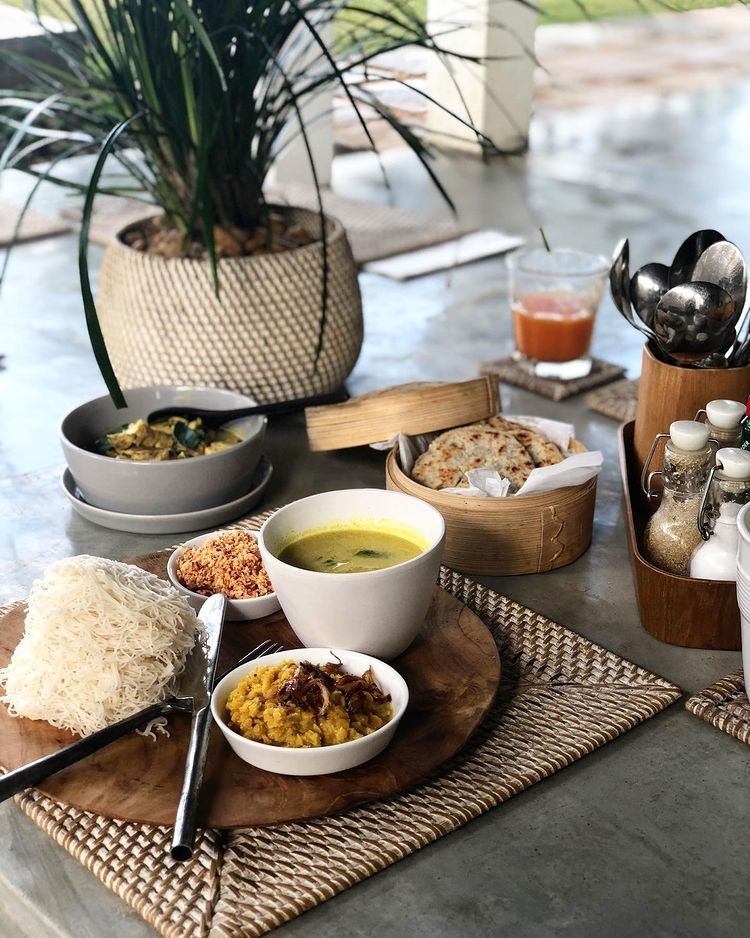

Cuisine drop down
Traditional Sri Lankan food is a wonderful mix of taste, colour and aroma. The island’s location made it a popular stopping off point for foreign traders, indigenous spices such as cinnamon and cloves have been enriched by diverse culinary influences from around the world.
For example, the Arabs introduced saffron and rose water, while the Portuguese not only brought chillies to the island but also culinary terms such as “temper”, which is derived from the Portuguese word temperado, meaning to fry and season.
The Dutch introduced recipes rich in eggs and butter, like Breudher, a Dutch Christmas cake. There are also Malay influences, such as the steamed dessert watalappam and the rice dishes pilau and biriyani.
Sri Lankan cuisine is one of the most complex cuisines of South Asia. Due to its proximity to South India, the cuisine of Sri Lanka shows some influence, yet is in many ways quite distinct. As a major trade hub, it draws influence from colonial powers that were involved in Sri Lanka and by foreign traders. Rice, which is consumed daily, can be found at any occasion, while spicy curries are favorite dishes for lunch and dinner. Some of the Sri Lankan dishes have striking resemblance to Kerala cuisine, which could be due to the similar geographic and agricultural features with Kerala.
Sri Lanka has long been renowned for its spices. Since ancient times, traders from all over the world who came to Sri Lanka brought their native cuisines to the island, resulting in a rich diversity of cooking styles and techniques.
The island nation's cuisine mainly consists of boiled or steamed rice served with curry. This usually consists of a "main curry" of fish, chicken, pork or mutton (typically goat), as well as several other curries made with vegetables, lentils and even fruit curries.
Side-dishes include pickles, chutneys and "sambols". The most famous of these is the coconut sambol, made of ground coconut mixed with chili peppers, dried Maldive fish and lime juice. This is ground to a paste and eaten with rice, as it gives zest to the meal and is believed to increase appetite.
Another well-known rice dish is kiribath, meaning "milk rice." In addition to sambols, Sri Lankans eat "mallung", chopped leaves mixed with grated coconut and red onions. Coconut milk is found in most Sri Lankan dishes to give the cuisine its unique flavor.
Sri Lankan people use spices liberally in their dishes and typically do not follow an exact recipe: thus, every cook's curry will taste slightly different. Furthermore, people from different regions of the island (for instance, hill-country dwellers versus coastal dwellers) traditionally cook in different ways while people of different ethnic and religious groups tend to prepare dishes according to their customs. Although Sri Lankan food appears similar to South Indian cuisine in its use of chilli, cardamom, cumin, coriander and other spices, it has a distinctive taste, and uses ingredients like dried Maldive fish which are local to the area.
Sri Lankan food is generally equivalent in terms of spiciness to South Indian cuisine, yet many spicy Sri Lankan preparations are believed to be among the world's hottest in terms of chilli content (Comparable to Sylhet and Bengal). There is a liberal use of different varieties of scorching hot chillies such as amu miris, kochchi miris, and maalu miris (capsicum) among others.
While native Sri Lankans are born into this cuisine and develop a healthy tolerance to spicy food, many visitors and tourists to the country often find the spiciness excessive. As a result, many local restaurants in developed and tourist areas offer special low-spice versions of local foods to cater to foreign palates, or have an alternative western menu for tourists. It is generally acceptable for tourists to request that the food is cooked with a lower chilli content to cater for the milder Western palate. The chili content in food cooked for public occasions is typically much less than home-cooked food.
Arabella on Boossa has an inhouse chef and a lunch/dinner menu that changes seasonally.
Our menu is a selection of fabulous Sri Lankan dishes as well as contemporary and traditional options. All made using the freshest local produce available.
Breakfast is included for all guests and you can choose from a variety of options.
Starbucks coffee, Ceylon tea and fresh juice are served.
The kitchen is open and available from 7am – 9pm daily.
